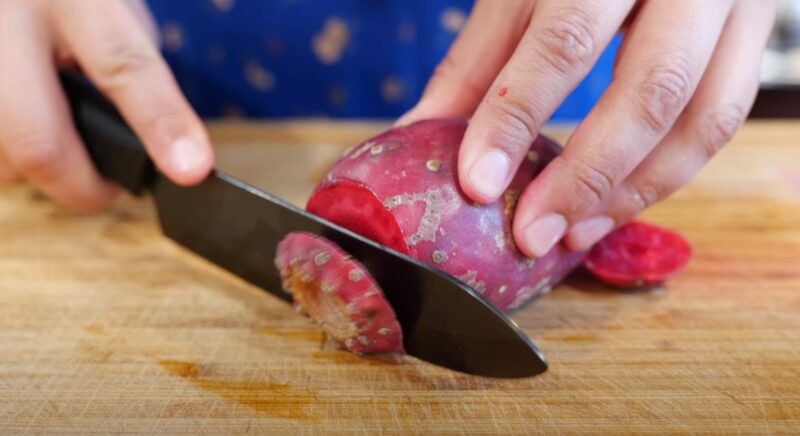The vibrant prickly pear cactus fruit, also known as “tuna,” stands out with its striking color and unique flavor. Rich in vitamins and minerals, this exotic fruit has gained popularity for its health benefits and culinary versatility.
However, its spiny exterior can make the cleaning process seem daunting. Fear not, as this comprehensive guide will lead you through the steps to safely and efficiently prepare prickly pear cactus fruit for consumption.
We’ll break down the process into three key phases: preparation, cleaning, and storage, ensuring you can enjoy this delicious fruit with ease.
Key Takeaways
- Safety is Paramount: Always wear thick gloves and use tongs to handle prickly pear cactus fruit, protecting yourself from the tiny, irritating spines known as glochids.
- Proper Preparation and Selection: Choose firm, ripe fruits yet give slightly under pressure, and ensure you have the right tools ready, such as a sharp knife and a cutting board, to facilitate the cleaning process.
- Efficient Cleaning Technique: Start by rinsing the fruit in water to loosen the glochids, then peel the skin off after slicing off the ends and making a lengthwise cut. Always finish with a thorough rinse under running water to remove any remaining spines.
- Versatile Storage Options: Enjoy the fruit fresh, or store it in the refrigerator for up to a week. For longer preservation, freeze the cleaned fruit on a baking sheet before transferring it to a freezer-safe container, allowing you to enjoy its unique flavor in various dishes over time.
What to Do in Advance?
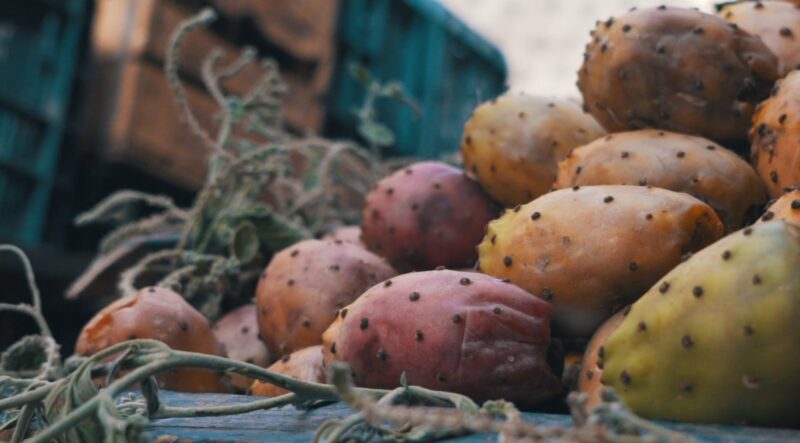
Before you start, it’s essential to have the right tools on hand. You’ll need a pair of thick gloves to protect your hands from the fruit’s tiny spines, known as glochids. A sharp knife and a cutting board are also crucial for slicing the fruit.
Also, consider having a pair of tongs and a large bowl filled with water to help in the cleaning process.
Selecting the Fruit
Choosing the right fruit is just as important as the cleaning process itself. Look for prickly pears that are deep in color and give slightly under pressure, indicating ripeness.
Avoid fruits with bruises or dry, shriveled spots, as these are signs of overripeness or spoilage.
Safety First
Safety cannot be overstated when handling prickly pear cactus fruit. The glochids can easily embed in your skin, irritating.
Wearing thick gloves throughout the process will protect your hands, and using tongs to hold the fruit can further minimize the risk of coming into contact with the spines.
How to Clean the Fruit Properly?
Begin by placing the fruit in a large bowl of water. Swirl them around with the tongs to help loosen the glochids.
This initial rinse won’t remove all the spines but will make the subsequent steps safer and easier.
Peeling the Fruit
After the rinse, it’s time to peel the fruit. Hold the fruit with tongs on the cutting board, slice off both ends with your knife, and make a shallow cut along the length of the fruit.
You can then use the knife or your gloved fingers to peel away the skin, revealing the fruit’s juicy interior.
Final Cleaning
With the fruit peeled, give it a final rinse under running water to wash away any remaining glochids. Be thorough, as even a few left behind can cause discomfort.
How to Preserve for Later Use?
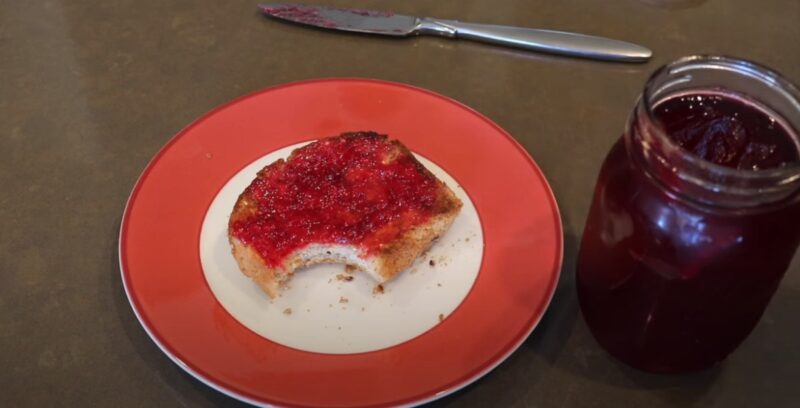
Prickly pear cactus fruit is best enjoyed fresh. You can eat it as is, use it in salads, or incorporate it into recipes like jams, jellies, or smoothies. Its sweet, melon-like flavor pairs well with a variety of dishes.
Refrigerating the Fruit
If you’re not planning to use the fruit immediately, store it in the refrigerator. Place the peeled fruit in an airtight container or wrap it tightly in plastic wrap.
It can be stored in the fridge for up to a week.
Freezing for Long-Term Storage
For longer preservation, prickly pear cactus fruit can be frozen. Cut the cleaned fruit into slices or cubes and spread them on a baking sheet to freeze individually.
Once frozen, transfer the pieces to a freezer-safe bag or container. This method prevents the pieces from sticking together, allowing you to use as much or as little as you need for future recipes.
Is There An Alternative Cleaning Method?
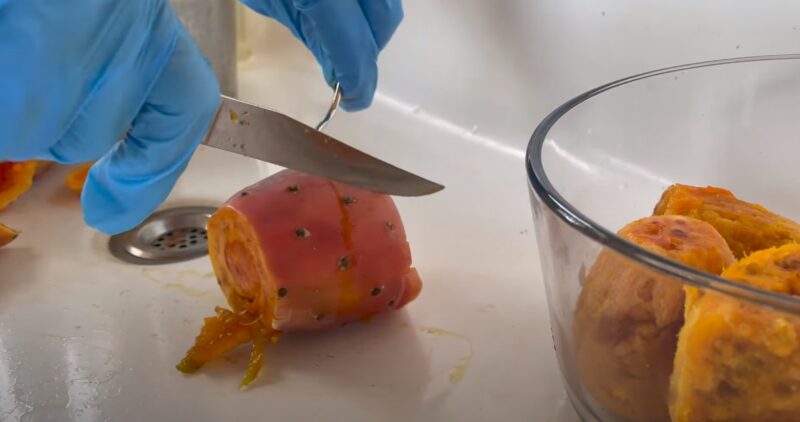
Handling and preparing prickly pear cactus fruit requires caution due to its tiny, hair-like spines known as glochids. While the traditional cleaning method involves water and manual peeling, there exists an alternative technique that can simplify the process and minimize the risk of getting pricked.
This method leverages heat to effectively remove the glochids, making the fruit safer to handle and prepare.
Equipment Needed
- A pair of long-handled tongs
- A gas stove, barbecue grill, or a blowtorch
- A clean sink or bowl filled with water
- A sharp knife and cutting board
Step-by-Step Guide
- Heat Application: Hold the prickly pear fruit with the tongs and rotate it over an open flame from a gas stove or a barbecue grill. If using a blowtorch, carefully apply heat all around the fruit’s surface. The goal is to singe off the glochids without cooking the fruit. This process should take just a few seconds for each fruit.
- Rinsing: Once the glochids have been singed, immediately submerge the fruit in a bowl of water or rinse under running water to cool it down and wash away any ash or loose spines. This step also helps to remove any residual glochids that weren’t completely burned away.
- Peeling: After rinsing, the fruit’s skin should be easier to handle. Place the fruit on a cutting board and use a sharp knife to slice off both ends. Make a lengthwise cut through the skin, then use your fingers or the knife to peel away the skin, revealing the juicy interior.
- Final Preparation: Once peeled, the prickly pear fruit is ready to be eaten as is or used in various recipes. Any remaining spines or singed areas can be trimmed away with a knife.
Advantages
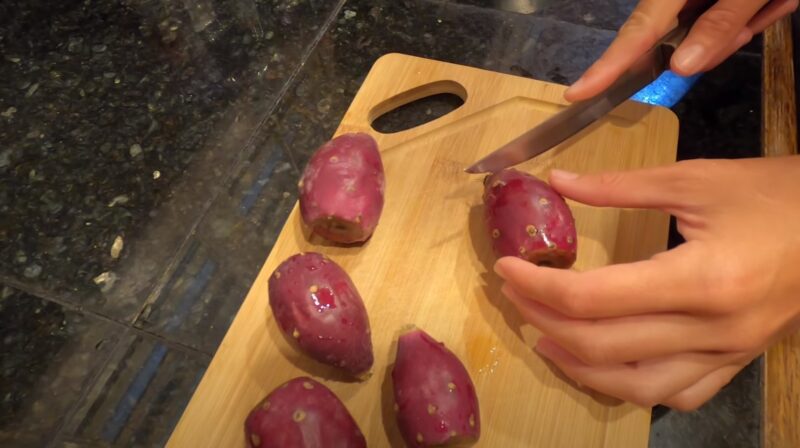
This alternative cleaning method offers several benefits:
- Efficiency: Singeing the glochids is faster than manually removing them with a knife or peeler.
- Safety: By eliminating the glochids through heat, the risk of getting pricked is significantly reduced.
- Simplicity: This method simplifies the preparation process, especially when handling a large quantity of fruit.
While this technique is effective, it’s important to proceed with caution and ensure proper ventilation when applying heat to the fruit. Experimenting with this method can make the task of preparing prickly pear cactus fruit less daunting and more accessible for those looking to enjoy its unique taste and nutritional benefits.
FAQ
Can I eat the seeds of prickly pear cactus fruit?
Yes, the seeds of prickly pear cactus fruit are edible, but they are quite hard. Some people choose to spit them out, while others enjoy the fruit whole, seeds included, for their nutritional content.
Is it possible to juice prickly pear cactus fruit?
Absolutely. After cleaning, the fruit can be juiced to make a vibrant, nutritious drink. The process involves blending the fruit’s flesh and then straining it to remove the hard seeds and any remaining solids.
How can I tell if a prickly pear is overripe?
Overripe prickly pears may have a fermented smell, become overly soft to the touch, and their skin might start to wrinkle. Such fruits should be avoided as their quality and taste may have deteriorated.
Can prickly pear cactus fruit cause allergies?
While rare, some individuals may experience an allergic reaction to prickly pear cactus fruit, similar to reactions from other fruits. Symptoms could include itching, swelling, or gastrointestinal discomfort.
What’s the best way to remove glochids from my skin if I get pricked?
If glochids get into your skin, gently applying and removing tape over the area can help pull them out. Soaking the area in warm water can also soften the skin and make removal easier.
Can I grow my prickly pear cactus from the fruit?
Yes, it is possible to grow a prickly pear cactus plant from seeds within the fruit. Clean the seeds thoroughly, let them dry, and then plant them in a suitable cactus potting mix, keeping them at a warm temperature and in indirect light until they germinate.
Final Words
In conclusion, cleaning prickly pear cactus fruit might initially appear challenging, but with the right approach, it becomes a simple task. By following this step-by-step guide, you’ll not only ensure safe handling of the fruit but also get to enjoy its delicious taste and nutritional benefits with minimal effort.
Whether you’re making a refreshing drink, a vibrant salad, or a sweet dessert, prickly pear cactus fruit offers a unique flavor profile that can enhance a wide range of dishes. Don’t miss out on our delicious food content.
Stay tuned for more!

